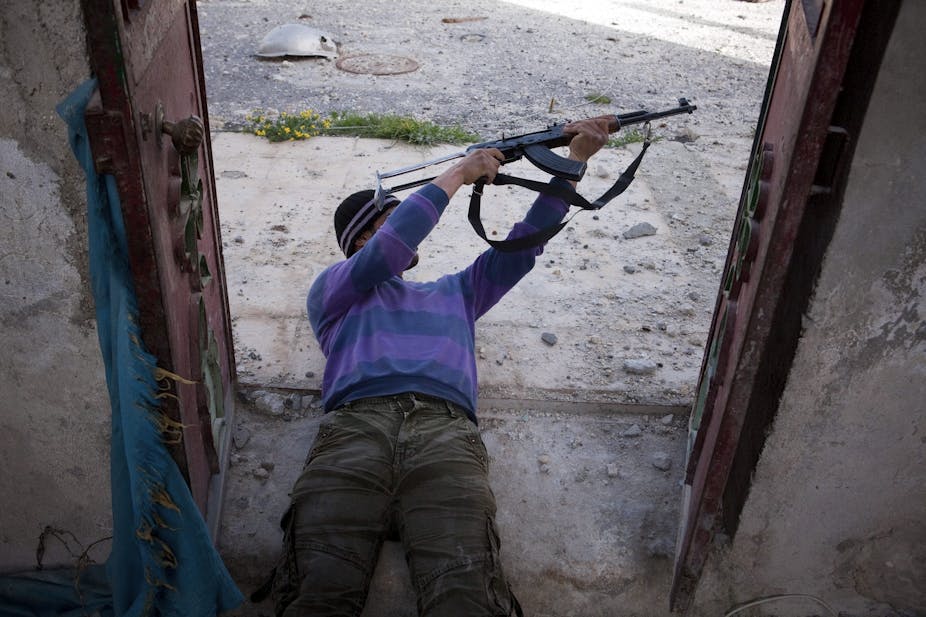The bloodbath in Syria continues apace and the decision by the European Union to provide arms to some rebel groups ensures that fighting will grow only more intense.
The hotly contested removal of the embargo on arming Syrian rebel groups will provide the rebels with much-needed assistance. However, it is unlikely to be decisive in tipping the war in their favour.
At the same time, Syrian president Bashar al-Assad’s Ba’athist regime has continued to receive extensive material support from its allies in Moscow and Tehran that will serve to harden and sustain its own efforts.
Spearheaded by France and Britain, the European decision to allow the arming of moderate opposition forces is aimed at putting political pressure on the Assad regime to come to the negotiating table, as well as counteracting the increasingly central role played by sectarian jihadist groups in the conflict.
European arms support for Syrian rebel forces will join similar efforts already in place by Turkey, Jordan and Gulf Cooperation Council states, notably Qatar, who have been sending arms into the combat zone for many months. Despite these efforts, however, the opposition forces have remained in a permanent state of logistical desperation and have been forced to build everything from shotguns to light artillery in makeshift workshops.
Although arms from Europe will be a welcome addition for the Syrian rebel forces, the equipment they are most desperate for still pose the same security concerns for its suppliers that it has throughout the conflict. The Assad regime has continued to pound opposition forces with armoured vehicles and aircraft that the rebels have very little answer to.
Although weapons do exist to counter these types of formidable machines, their potential proliferation outside the conflict zone remains problematic . Man-portable air-defence systems in particular are a major risk to civilian air traffic, especially when considering the presence of jihadist groups in Syria who have sworn allegiance to the al-Qaeda ethos.
Although the European design is to marginalise these groups by equipping and empowering their secular counterparts, the reality of implementing such an approach is far more complicated than it may first appear. While jihadist groups like Jabhat al-Nusra and Ansar al-Sham have displayed a degree of cohesion and tactical efficacy, secular groups lack a similar level of unity.
Schisms within the Syrian National Council remain prevalent, to the extent that the organisation has lacked a formal chairman since the resignation of Moaz al-Khatib in March. In real terms this poses a simple practical question to the European countries: even if they want to arm opposition, who do they arm?
Meanwhile, the regime has shown signs of increasing international support over the last few months. Where just a few months ago some analysts were suggesting the Ba’athists were scraping the bottom of the barrel (bomb), evidence suggests that Syrian forces are now utilising an increasing range of munitions supplied recently from Iran and Russia.
Such support is not limited to just artillery shells, however. UN officials have suggested the surface-to-air missile convoy targeted in the January 31 Israeli airstrikes around Rif Dimashq was fresh off the boat from the Russian-staffed port of Tartus.

Concerns also continue on the ambiguities surrounding a deal between Moscow and Damascus that could see a transfer of the S-300, a missile system that would seriously threaten the capabilities of Western aircraft to conduct strikes in Syrian airspace.
Outside of such “game-changers”, a continual flow of small arms, uniforms and equipment appears to be threading its way into regime hands. Even the ubiquitous British woodland camouflage uniforms worn by the Syrian army are being slowly supplanted by Russian digital patterns in photos over the last few months.
At the same time, repeated chemical weapon use claims on all sides have remained largely unsubstantiated. Beyond vague claims of respiratory troubles, the few fatalities brought on by the alleged attacks may very well have been the result of pre-existing medical conditions exacerbated by something akin to CS riot gas. Let us not forget Saddam Hussein’s use of VX, Sarin and Mustard agents on the Kurdish town of Halabja in 1988 that left an estimated 5,000 dead and 10,000 wounded. Chemical weapons don’t tend to be something states use sparingly when they wheel them out.
Despite the extremely sketchy evidence of chemical weapon use, the lifting of the EU embargo will no doubt see a flood of new Euro arms injected into the conflict. Regardless of estimates of over 80,000 Syrian deaths as a direct result of these sorts of conventional weapons, the media remains fixated on Assad’s stocks of Sarin and VX.
Meanwhile, despite their banality, the real killers in this conflict will remain the rifle, the machine gun and the bomb, which will likely now be available in even greater numbers than before. The prospect of peace in Syria remains desperately remote.

